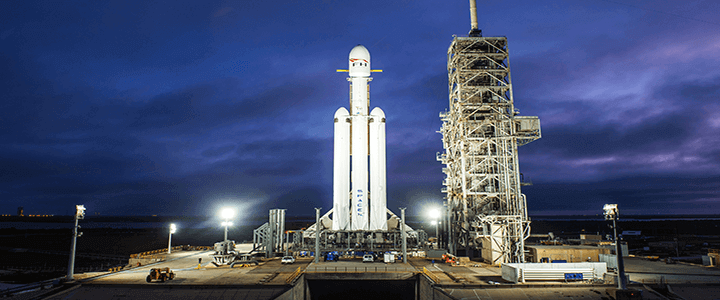No matter what happened in Tuesday’s test launch of the new SpaceX Falcon Heavy rocket, one thing was certain: Elon Musk was losing his Tesla Roadster in spectacular fashion.
Either the test would end with the rocket disintegrating, or the 2,723-pound car would wind up in orbit… not around the Earth, but around the sun (assuming the rocket’s second stage survives the transit through the Van Allen radiation belts and is able to reignite).
NEEDLESSLY LOWERED EXPECTATIONS
Launching this payload into space would be proof that the Falcon Heavy will be able to do what it is intended to do, which is launch massive payloads into low-earth orbit, the altitude of many satellites as well as the
International Space Station. (Two excellent graphics that depict different orbital altitudes are available here and here). This is incredibly important for government and military space operations.
For his part, Musk did his best to lower expectations, saying that he was worried the launch would fail and damage the historic launch pad 39A, used for the the Apollo moon launches, and that he’d consider anything that cleared the tower to be a success. He told CNN that “People are coming from all around the world to see what will either be a great rocket launch, or the best fireworks display they’ve ever seen.”
But his hedging was, as it turned out, completely unnecessary. The rocket not only cleared the tower intact, it continued on its journey almost flawlessly. It did not disintegrate, its two external boosters separated as designed, and returned the Kennedy Space Center in Florida where they landed simultaneously in what can only be described as a tightly choreographed ballet. The lone blemish on the day, not shown on the webcast, was the fact that the first stage’s central core failed to land properly on a drone ship in the Atlantic Ocean, plunging into the water instead.
Also caught on camera was the separation of the payload fairing, revealing Musk’s roadster with a space-suited mannequin behind the wheel, and the phrase “Don’t Panic,” an homage to Hitchhiker’s Guide to the Galaxy series author Douglas Adams, displayed on its dashboard video screen. Fittingly, the mannequin, named Starman for the David Bowie song, also carried a towel.
WHY THIS IS A BIG DEAL
NASA and SpaceX both still harbor ambitions of sending humans to Mars. This will require a rocket even bigger than the Falcon Heavy. Musk has nicknamed his the BFR (figure it out for yourself). Successfully developing the Falcon Heavy is a big step toward realizing the BFR dream. But there’s a more immediate need fulfilled by the Falcon Heavy.
The federal government in general, and the Department of Defense in particular, rely on a diversity of suppliers to keep acquisition programs on-track. But just as there are few companies capable of building a cutting-edge fighter plane or an aircraft carrier, there are few companies capable of launching payloads into orbit.
Currently, only one company, the Boeing–Lockheed Martin joint venture United Launch Alliance with its Delta IV Heavy, is capable of sending the largest satellites from the National Reconnaissance Office, the keeper of the nation’s spy satellites, into orbit. And since the retirement of the space shuttle in 2011, NASA has depended on Russian rockets and capsules to ferry astronauts to and from the International Space Station.
Clearly, relations between Russia and the U.S. are not the best right now. While the space program has been largely immune from the geopolitical wrangling, there is no guarantee that goodwill will continue indefinitely. NASA is counting on SpaceX and ULA to remove that Russian dependency. Both companies will be testing their crew capsules this year. ULA will perform an uncrewed test in August and a crewed test in November. SpaceX’s tests of its Dragon Crew capsule will be in August and December. Both companies can send their crew capsules on their smaller Atlas V and Falcon 9 rockets, but there’s still a need for heavy lift.
Once certified, the Falcon Heavy program will do two things: it will prove the company is capable of reliably developing new technology, and it will give SpaceX the ability, in its own words, to boost “more than twice the payload” of the Delta IV Heavy, “at one-third the cost.” This will provide the government a powerful and compelling option for launching its most sensitive payloads. It will also encourage further innovation in booster technology among all the players in the industry. There’s no telling where this new, privatized space race will go.
And that’s a good thing for NASA and the Department of Defense.
INCREASED COMPETITION MEANS LOWER COSTS
We’ve spent a lot of time on the effects of sequestration and other budget constraints here recently, so it should go without saying that anything that allows the DOD to do its job at a lower cost, especially when it comes to massively expensive undertakings like shooting payloads into space, is a welcome addition.
While it may have been one small step for a Tesla, Tuesday’s launch was one giant leap for both government and industry.
Bravo.




